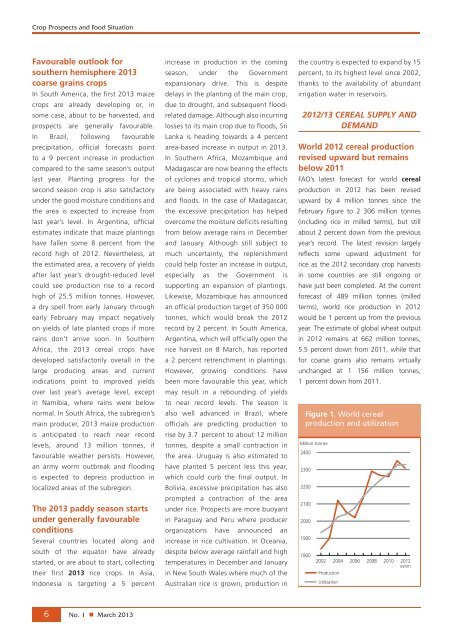You also want an ePaper? Increase the reach of your titles
YUMPU automatically turns print PDFs into web optimized ePapers that Google loves.
<strong>Crop</strong> <strong>Prospects</strong> and <strong>Food</strong> <strong>Situation</strong><br />
Favourable outlook for<br />
southern hemisphere 2013<br />
coarse grains crops<br />
In South America, the first 2013 maize<br />
crops are already developing or, in<br />
some case, about to be harvested, and<br />
prospects are generally favourable.<br />
In Brazil, following favourable<br />
precipitation, official forecasts point<br />
to a 9 percent increase in production<br />
compared to the same season’s output<br />
last year. Planting progress for the<br />
second season crop is also satisfactory<br />
under the good moisture conditions and<br />
the area is expected to increase from<br />
last year’s level. In Argentina, official<br />
estimates indicate that maize plantings<br />
have fallen some 8 percent from the<br />
record high of 2012. Nevertheless, at<br />
the estimated area, a recovery of yields<br />
after last year’s drought-reduced level<br />
could see production rise to a record<br />
high of 25.5 million tonnes. However,<br />
a dry spell from early January through<br />
early February may impact negatively<br />
on yields of late planted crops if more<br />
rains don’t arrive soon. In Southern<br />
Africa, the 2013 cereal crops have<br />
developed satisfactorily overall in the<br />
large producing areas and current<br />
indications point to improved yields<br />
over last year’s average level, except<br />
in Namibia, where rains were below<br />
normal. In South Africa, the subregion’s<br />
main producer, 2013 maize production<br />
is anticipated to reach near record<br />
levels, around 13 million tonnes, if<br />
favourable weather persists. However,<br />
an army worm outbreak and flooding<br />
is expected to depress production in<br />
localized areas of the subregion.<br />
The 2013 paddy season starts<br />
under generally favourable<br />
conditions<br />
Several countries located along and<br />
south of the equator have already<br />
started, or are about to start, collecting<br />
their first 2013 rice crops. In Asia,<br />
Indonesia is targeting a 5 percent<br />
6<br />
No. 1 n March 2013<br />
increase in production in the coming<br />
season, under the Government<br />
expansionary drive. This is despite<br />
delays in the planting of the main crop,<br />
due to drought, and subsequent flood-<br />
related damage. Although also incurring<br />
losses to its main crop due to floods, Sri<br />
Lanka is heading towards a 4 percent<br />
area-based increase in output in 2013.<br />
In Southern Africa, Mozambique and<br />
Madagascar are now bearing the effects<br />
of cyclones and tropical storms, which<br />
are being associated with heavy rains<br />
and floods. In the case of Madagascar,<br />
the excessive precipitation has helped<br />
overcome the moisture deficits resulting<br />
from below average rains in December<br />
and January. Although still subject to<br />
much uncertainty, the replenishment<br />
could help foster an increase in output,<br />
especially as the Government is<br />
supporting an expansion of plantings.<br />
Likewise, Mozambique has announced<br />
an official production target of 350 000<br />
tonnes, which would break the 2012<br />
record by 2 percent. In South America,<br />
Argentina, which will officially open the<br />
rice harvest on 8 March, has reported<br />
a 2 percent retrenchment in plantings.<br />
However, growing conditions have<br />
been more favourable this year, which<br />
may result in a rebounding of yields<br />
to near record levels. The season is<br />
also well advanced in Brazil, where<br />
officials are predicting production to<br />
rise by 3.7 percent to about 12 million<br />
tonnes, despite a small contraction in<br />
the area. Uruguay is also estimated to<br />
have planted 5 percent less this year,<br />
which could curb the final output. In<br />
Bolivia, excessive precipitation has also<br />
prompted a contraction of the area<br />
under rice. <strong>Prospects</strong> are more buoyant<br />
in Paraguay and Peru where producer<br />
organizations have announced an<br />
increase in rice cultivation. In Oceania,<br />
despite below average rainfall and high<br />
temperatures in December and January<br />
in New South Wales where much of the<br />
Australian rice is grown, production in<br />
the country is expected to expand by 15<br />
percent, to its highest level since 2002,<br />
thanks to the availability of abundant<br />
irrigation water in reservoirs.<br />
2012/13 CEREAL SUPPLY AND<br />
DEMAND<br />
World 2012 cereal production<br />
revised upward but remains<br />
below 2011<br />
FAO’s latest forecast for world cereal<br />
production in 2012 has been revised<br />
upward by 4 million tonnes since the<br />
February figure to 2 306 million tonnes<br />
(including rice in milled terms), but still<br />
about 2 percent down from the previous<br />
year’s record. The latest revision largely<br />
reflects some upward adjustment for<br />
rice as the 2012 secondary crop harvests<br />
in some countries are still ongoing or<br />
have just been completed. At the current<br />
forecast of 489 million tonnes (milled<br />
terms), world rice production in 2012<br />
would be 1 percent up from the previous<br />
year. The estimate of global wheat output<br />
in 2012 remains at 662 million tonnes,<br />
5.5 percent down from 2011, while that<br />
for coarse grains also remains virtually<br />
unchanged at 1 156 million tonnes,<br />
1 percent down from 2011.<br />
Figure 1. World cereal<br />
production and utilization<br />
Million tonnes<br />
2400<br />
2300<br />
2200<br />
2100<br />
2000<br />
1900<br />
1800<br />
2002<br />
2004<br />
Production<br />
Utilization<br />
2006<br />
2008<br />
2010<br />
2012<br />
estim.


